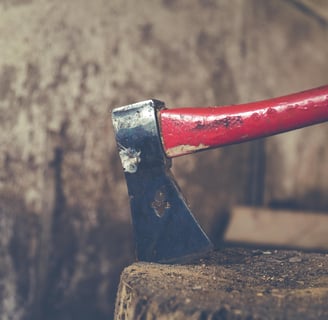Debunked! 7 Common Firewood Myths (Don’t Fall for #4)
Firewood is a timeless fuel source, but misinformation about its use is as persistent as smoke in a poorly ventilated room. Whether you’re a seasoned wood burner or a first-time fireplace owner, believing these myths can lead to inefficient burns, safety hazards, or even environmental harm. Let’s cut through the confusion and expose the truth behind seven widespread firewood misconceptions.
2/7/20252 min read


Myth 1: “Green Wood Burns Just Fine if You’re in a Pinch”
The Truth: Burning unseasoned (green) wood is a recipe for trouble. Freshly cut wood contains 40–60% moisture, which forces your fire to waste energy boiling off water instead of producing heat. This leads to excessive creosote buildup in chimneys—a major fire hazard—and releases thick, smelly smoke that irritates lungs and neighbors.
Fix: Always season wood for 6–12 months. Use a moisture meter to ensure levels drop below 20% before burning.
---
Myth 2: “All Softwoods Are Terrible for Firewood”
The Truth: Softwoods like pine or cedar get a bad rap for their resin content, but they’re not universally “bad.” While resin can spark and pop (making them risky for open indoor fires), softwoods ignite quickly and are ideal for outdoor fire pits, campfires, or kindling. Their lower BTU output simply means they burn faster.
Fix: Reserve resinous softwoods for outdoor use and mix with hardwoods for longer-lasting indoor fires.
---
Myth 3: “You Can’t Over-Dry Firewood”
The Truth: Overly dry wood (below 15% moisture) burns too fast, wasting energy and requiring constant reloading. While it’s safer than green wood, excessively seasoned wood sacrifices efficiency.
Fix: Store wood under cover but with airflow to maintain a 15–20% moisture sweet spot.
Myth 4: “Old Firewood is Always Good Firewood”
The Truth: Firewood doesn’t last forever. Wood left uncovered for years absorbs moisture, rots, or becomes a pest paradise. Fungus-infested or termite-ridden wood can introduce problems into your home.
Fix: Use seasoned wood within 2–3 years. Inspect for mold, holes, or spongy texture before burning.
---
Myth 5: “Any Wood Works for Cooking or Smoking”
The Truth: Toxic woods like poison oak, pressure-treated lumber, or painted scraps release dangerous chemicals when burned. Even some hardwoods (e.g., walnut) can impart bitter flavors to meat.
Fix: Stick to food-safe hardwoods (apple, hickory, oak) and avoid processed or unknown wood.
---
Myth 6: “How You Stack Firewood Doesn’t Matter”
The Truth: Haphazard stacking slows drying, promotes rot, and invites pests. Tightly packed stacks limit airflow, while loose piles risk collapsing.
Fix: Use the “top cover” method: Stack wood loosely in rows with bark-side-down and cover only the top ⅓ with a tarp to shield from rain while allowing airflow.
---
Myth 7: “Firewood ‘Expires’ After Two Seasons”
The Truth: Properly stored firewood can last 3–4 years. The key is keeping it dry, elevated, and ventilated. Rot occurs from ground contact or constant moisture, not age alone.
Fix: Rotate your stockpile—use older wood first and refresh your supply annually.
---
Bonus: A Myth That’s Actually True
“Burning Firewood Can Be Eco-Unfriendly”: While wood is renewable, unsustainable harvesting or burning green wood releases excess carbon and particulates. Solution: Source local, deadfall wood, maintain hot fires, and upgrade to an EPA-certified stove.
---
Conclusion
Ditching firewood myths isn’t just about boosting efficiency—it’s about safety, cost savings, and respecting the environment. By seasoning properly, choosing the right wood for the job, and storing with care, you’ll master the art of wood burning.
This post may contain affiliate links. If you make a purchase through these links, I may earn a small commission at no extra cost to you. Thank you for supporting FirewoodFanatic.com!


